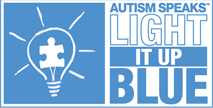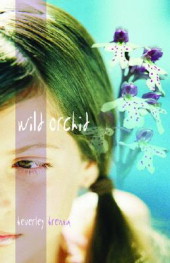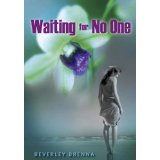Light It Up Blue on April 2
April is National Autism Awareness Month, which will be kicked off today, Monday, April 2, with an International Autism Awareness Day. Join Autism Speaks in the third annual “Light It Up Blue” day to help shine a light on autism. The entire world is going blue to increase awareness about autism. You can help by changing the light bulb in your front porch light to blue, turning your website blue, reviewing a children’s book on autism, or watching a library copy of the award-winning HBO movie “Temple Grandin,” and learning more about the autism spectrum.
According to a report released March 29 by the federal Centers for Disease Control and Prevention, the estimated number of U.S. autistic kids have skyrocketed by 78 percent since 2000. Now, one in 88 American kids has autism, according to the new figures. Among boys, it’s one in 54. The big question is “why?” One expert said, “better diagnosis, broader diagnosis, better awareness, and roughly 50 percent of ‘We don’t know’.” Another advocate said, “we have an epidemic of autism in the United States.”
This is a unique global opportunity to help raise awareness about the growing public health concern that is autism. Iconic landmarks around the world will Light It Up Blue to show their support today. Among the 2,000 buildings going blue last year were the: NY Stock Exchange, Empire State Building, Christ the Redeemer in Brazil, Niagara Falls, Al Anoud Tower in Saudi Arabia, Cairo Tower in Egypt, Great Buddha at Hyogo in Japan, CN Tower in Canada and Sydney Opera House in Australia.
The month will be filled with activities for families and friends, so make sure you check out Autsim Speaks. Their website has a wealth of information, tool kits for newly diagnosed children, facts, treatment information, research and resources on the Autism Spectrum. I will be reviewing some new books on autism in April and all year-long. I hope you will join me! Light it up Blue today!
Since April 2011, I have reviewed 13 books in the Autism Spectrum. You can click on Autism Spectrum and Asperger’s Syndrome in the “Topics” side bar to the right of my blog to find all the reviewed books. The titles include Picture Books (PB), Middle Grade (MG), Young Adult (YA) and books for Parents. Titles include:
I Am in Here: The Journey of a Child with Autism, Elizabeth M. Bonker and Virgina Breen (YA/Adult)
How to Talk to an Autistic Kid, Daniel Stefanski (MG)
Following Ezra: What One Father Learned About Gumby, Otters, Autism and Love from His Extraordinary Son, Tom Fields-Meyer (Parent)
I’m Here, Peter Reynolds (PB)
Mocking Bird, Katherine Erskine (MG)
Wild Orchid, Beverley Brenna (YA)
Waiting for No One , Beverley Brenna (YA) (second book in a trilogy)
Rules, Cynthia Lord (MG)
A Friend Like Henry, Nuala Gardner (Parent)
Different Like Me: My Book of Autism Heroes, Jennifer Elder (MG)
Marcelo in the Real World, Francisco X. Stork (YA)
Not My Boy, Rodney Peete (Parent)
My Brother Charlie, Holly and Ryan Elizabeth Peete, (PB)



